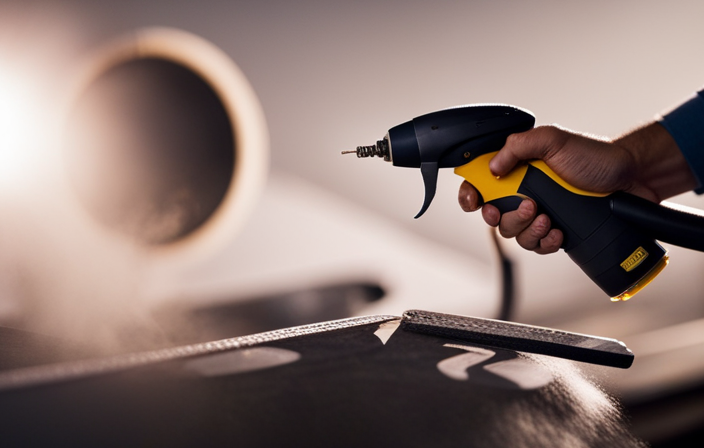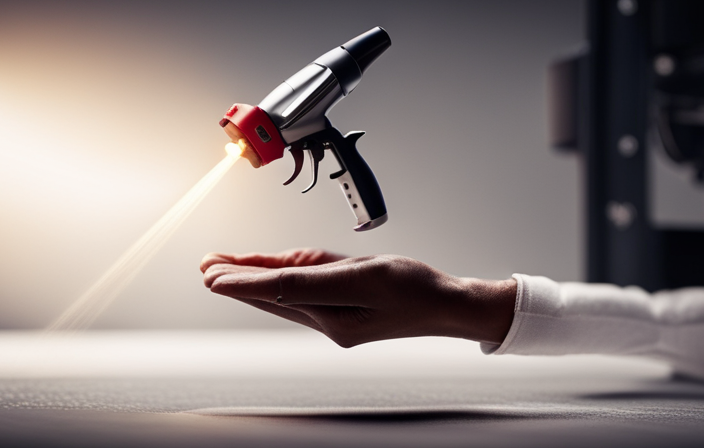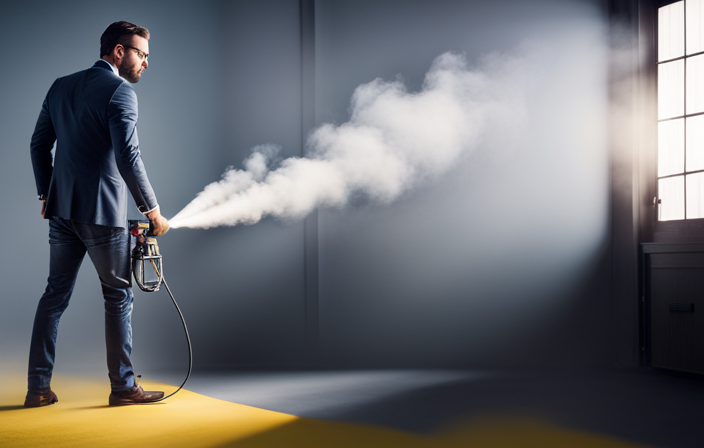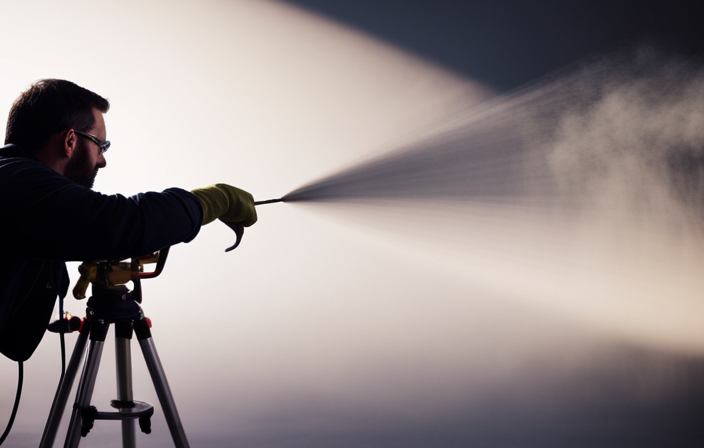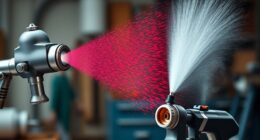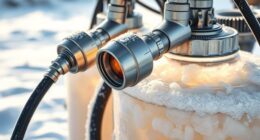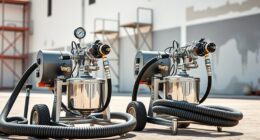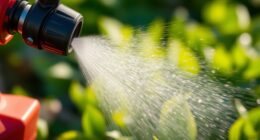Are you wondering how to properly clean an airless paint sprayer? Look no further! In this article, I will guide you through each step of the cleaning process for your airless paint sprayer, ensuring it stays in top condition for all your future painting projects.
Cleaning an airless paint sprayer is an essential task that should not be overlooked, as it helps to maintain the efficiency and longevity of the equipment. By following these simple yet effective cleaning techniques, you can prevent clogs, ensure a smooth paint application, and extend the lifespan of your sprayer.
So, let’s dive in and learn how to clean an airless paint sprayer like a pro!
Key Takeaways
- Regular inspections and part replacements are necessary for optimal sprayer performance and results.
- Proper storage techniques, such as wrapping and storing in a cool, dry place, help maintain the sprayer’s condition and prevent rusting and damage.
- Thorough cleaning and flushing after each use, as well as regular maintenance of filters, nozzles, and tips, prevent clogs, buildup, and ensure optimal performance.
- Maintaining functionality and longevity of the sprayer is crucial for its effective performance in future painting projects.
Gather the necessary cleaning supplies
Now, you’ll want to gather all the necessary cleaning supplies. Cleaning techniques for an airless paint sprayer require a few specific products to ensure a thorough and effective cleaning process.
The best cleaning products to have on hand include a high-quality paint thinner or solvent, a cleaning brush with stiff bristles, a bucket or container for cleaning solution, and safety equipment such as gloves and goggles.
When it comes to cleaning an airless paint sprayer, precision is key. You need to use the right products and techniques to remove any residual paint or debris that may be clogging the system.
Once you have gathered all the necessary supplies, you can move on to the next step – disconnecting the sprayer from the power source.
Disconnect the sprayer from the power source
To safely perform maintenance, it’s important to unplug the device from the electrical outlet. Cleaning an airless paint sprayer requires taking certain precautions to ensure safety and effectiveness. Here are four steps to follow when disconnecting the sprayer from the power source:
- Turn off the power switch on the sprayer unit.
- Unplug the power cord from the electrical outlet.
- Disconnect any additional power sources, such as batteries or generators.
- Ensure no power is flowing to the sprayer by testing the power outlet with a voltage tester.
By following these cleaning precautions and properly disconnecting the sprayer from the power source, you can avoid any potential accidents or damage.
Now, let’s move on to the next step and release any remaining pressure in the system.
Release any remaining pressure in the system
Before moving forward, make sure to relieve all remaining pressure in the system. This is an essential step in safely cleaning an airless paint sprayer. To do this, locate the pressure relief valve on the sprayer and turn it counterclockwise. This will gradually release the pressure inside the system.
Keep in mind that the pressure can be quite high, so it’s important to do this slowly and cautiously. Once the pressure is fully released, you can proceed with the cleaning process. Remember, properly relieving the pressure not only ensures your safety but also helps maintain the longevity of your airless paint sprayer.
Now that the pressure is released, let’s move on to the next step: removing the spray tip and guard.
Remove the spray tip and guard
Once you’ve relieved the pressure, it’s time to bid farewell to the spray tip and guard, setting them free from their paint-spraying duties.
Removing the spray tip and guard is an essential step in maintaining your airless paint sprayer and troubleshooting spray tip clogs. To do this, simply twist the guard counterclockwise and pull it off. Then, use a wrench to unscrew the spray tip from the gun. Be careful not to damage the delicate tip while doing so.
Inspect the spray tip and guard for any signs of wear or damage. If necessary, clean them thoroughly using a brush and solvent. Once clean, reassemble the spray tip and guard, ensuring they are securely tightened. This will ensure optimal performance when you move on to the next step: flushing the system with clean water or solvent to remove any remaining paint residue.
Flush the system with clean water or solvent
Now it’s time to give your system a refreshing rinse with water or solvent. Cleaning techniques are crucial to maintain the efficiency and longevity of your airless paint sprayer. Start by choosing the right cleaning solution based on the type of paint or coating used.
For water-based materials, flush the system with clean water. This will remove any remaining paint particles and residue from the spray tip, guard, and other components. If you used solvent-based materials, use an appropriate solvent to clean the system thoroughly. Make sure to follow the manufacturer’s instructions for the recommended solvent and cleaning procedure.
Flush the system until the water or solvent runs clear, ensuring all paint is removed. This step guarantees that your airless paint sprayer is ready for the next project.
Moving forward, let’s discuss how to disassemble and clean the fluid filter.
Disassemble and clean the fluid filter
To properly maintain your system, you should regularly disassemble and clean the fluid filter, as it plays a vital role in preventing clogs and ensuring smooth operation. Did you know that a clogged filter can reduce the efficiency of your sprayer by up to 50%?
Before disassembling the filter, it’s important to take certain precautions. First, make sure the sprayer is turned off and the pressure is released. Then, remove the filter housing carefully to avoid any damage.
Once disassembled, you can clean the filter using either clean water or a solvent. Be sure to follow the manufacturer’s instructions for the proper cleaning agent options.
After cleaning, reassemble the filter and ensure it’s securely in place before proceeding to clean the spray gun and hose.
Clean the spray gun and hose
Ensure that you thoroughly rinse and dry the spray gun and hose to remove any residue or debris that could affect the performance of your system. Start by disconnecting the hose from the spray gun and flushing it with clean water to remove any paint or other materials. Use a soft brush or cloth to scrub the inside of the hose, paying close attention to any clogs or buildup.
Rinse the hose thoroughly and allow it to air dry before reattaching it to the spray gun. Next, clean the spray gun by removing the nozzle and soaking it in a cleaning solution. Use a brush or cloth to remove any remaining paint or debris from the gun body. Rinse the gun with clean water and dry it completely before reassembling.
With the spray gun and hose cleaned, you can now move on to cleaning the pump and prime valve to ensure optimal performance.
Clean the pump and prime valve
Once you’ve completed cleaning the spray gun and hose, it’s time to give your attention to the pump and prime valve, ensuring they are free of any debris or buildup that could hinder their performance. Cleaning the pump and prime valve is essential for maintaining the functionality of your airless paint sprayer. To clean the pump, start by removing the inlet and outlet hoses. Check the pump filter for any dirt or debris and clean it thoroughly. Next, clean the nozzle and tip by using a small brush or toothpick to remove any dried paint or residue. Be sure to clean all the crevices and openings to ensure optimal spray performance. Once the pump and prime valve are clean, you can move on to inspecting and replacing any worn or damaged parts in order to keep your airless paint sprayer in top condition.
Inspect and replace any worn or damaged parts
Inspecting and replacing any worn or damaged parts can significantly improve the performance and longevity of your sprayer. Are you aware of the potential risks if these parts are neglected?
Inspecting parts is crucial to ensure that your airless paint sprayer is functioning at its best. Start by examining the nozzle, hose, and gun for any signs of wear or damage. Replace any worn or damaged parts immediately to prevent any leaks or malfunctions during operation.
Additionally, check the motor and pump for any abnormalities or unusual noises. Replacing damaged parts is essential to maintain the efficiency and effectiveness of your sprayer.
By regularly inspecting and replacing worn or damaged parts, you can ensure that your sprayer operates smoothly and delivers optimal results.
Now, let’s transition to the next section on how to store the sprayer properly for future use.
Store the sprayer properly for future use
To properly store your sprayer for future use, make sure you carefully wrap and protect all parts and securely store them in a designated area. This will ensure that your sprayer remains in optimal condition and ready for use when you need it. Here are some proper storage techniques to prevent clogs and buildup:
- Clean and flush the sprayer thoroughly after each use to remove any remaining paint or debris.
- Remove and clean the filters, nozzles, and tips to prevent any dried paint or residue from causing clogs.
Store the sprayer in a cool, dry place to avoid moisture and potential rusting.
By following these steps, you can extend the lifespan of your airless paint sprayer and ensure its effective performance for future painting projects. Proper storage is key to maintaining the functionality and longevity of your sprayer.
Frequently Asked Questions
Can I use any cleaning supplies or are there specific ones I need to use?
You should only use suitable cleaning supplies for an airless paint sprayer. It is important to choose products that are specifically designed for cleaning paint sprayers to ensure proper maintenance and prevent damage.
How do I know if there is any remaining pressure in the system before disconnecting?
To release pressure and safely disconnect an airless paint sprayer, follow these steps. First, turn off the sprayer and engage the trigger lock. Then, slowly open the bleed valve to release any remaining pressure before disconnecting any fittings or hoses.
Are there any special instructions for cleaning the fluid filter?
When cleaning the fluid filter of an airless paint sprayer, it is important to follow specific cleaning techniques and maintenance tips. Ensure to remove any debris or clogs, and clean it thoroughly to maintain optimal functionality.
How often should I inspect and replace worn or damaged parts?
Inspect and replace worn or damaged parts regularly to ensure optimal performance and prolong the lifespan of your airless paint sprayer. By doing so, I guarantee you’ll be painting like a pro for years to come.
What is the proper way to store the sprayer for future use?
To ensure proper storage of the airless paint sprayer for future use, it is important to follow these maintenance tips. Clean the sprayer thoroughly, remove any excess paint, and store it in a cool, dry place to prevent damage.
Conclusion
In conclusion, keeping your airless paint sprayer clean is crucial for its optimal performance and longevity. By following these steps, you can ensure that your sprayer is free from clogs and debris, allowing for smooth and precise paint application.
Remember to always store the sprayer properly to avoid any damage or unnecessary wear. So, take the time to clean your sprayer thoroughly and maintain its efficiency, for a paint job that’s both professional and seamless.
